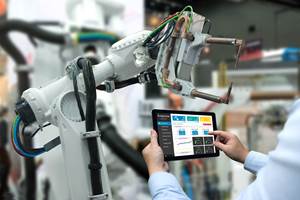Training to Meet Your Specific CNC Operator Needs
You’ve identified the right candidates and decided to train them in house, now how do you make sure the training actually covers what your particular shop needs?
It sounds simple: Initiate training that addresses your company’s specific needs. The best in-plant training programs do just that. Actually accomplishing this goal, however, usually requires a pretty big commitment on the company’s part.
In the CNC environment, the position of CNC operator tends to be the most difficult to keep fully staffed, simply because it requires the largest number of people. Here are some suggestions that should help you assess your needs for this critical position:
Define your expectations. What specific tasks must people be able to do in order to perform in the position for which they are being trained? Enlist the help of current workers as well as their managers to come up with a list of answers to this question. Include those tasks the current workers are doing, along with anything they could be doing better. This will provide a checklist for choosing and/or developing a training curriculum.
Work from general to specific. One of your general operator tasks may be “make sizing adjustments on workpieces during the production run,” but you also should list the individual subtasks required to perform this task. You may come up with: 1) measure a workpiece attribute; 2) determine the target value, and high and low limits for the workpiece attribute; 3) determine when the attribute is approaching a tolerance limit; 4) determine the amount of deviation; and 5) adjust the appropriate offset by the deviation amount.
You will likely come up with a pretty long list of tasks and subtasks, but avoid the temptation to skip or skim through this step. You must ensure that there are no holes in your curriculum.
Group related topics. This may be more related to actual curriculum development but can be done while assessing needs. For CNC operator training, you might come up with something like:
• Basic machining practices (shop safety, shop math, blueprint reading, tolerance interpretation, measuring devices).
• Machining operations and cutting tools (specific to machine type).
• Understanding the CNC machine being used (components, axes, buttons and switches).
• CNC compensation as it relates to making sizing adjustments.
• Tasks related to completing a production run (workpiece loading/unloading, cleaning and deburring workpieces, measuring workpiece attributes, sizing adjustments, replacing worn tools).
Limit topics to those that address your specific needs. Several of these individual topics could fill the curriculum of an entire class. Of course, it will not hurt if employees know more than they need to know. However, paring down content to only those specific skills you expect of trainees will minimize what they must learn and, in turn, shorten the time required for training. It will also keep you from confusing trainees with content that will not be applied in the immediate future.
The mores specific you are, the more targeted your training can be. Here are a few suggestions:
Basic machining practices. Your company surely has some practices that are unique to its operations. For instance, while most general safety practices will likely apply, you may have specific hazards that require other additional measures. Maybe you machine titanium or magnesium, and therefore operators must be aware of the related fire hazard. Similarly, the way you create, dimension and tolerance workpiece drawings is probably unique to your company. You may, for example, exclusively use high/low-limit tolerance values to specify attribute dimensions. In this case, there is no need to address other tolerancing methods in your training. Your company probably also uses a unique set of measuring devices. Target them, and only them, for lots of practice during training.
Machining operations and cutting tools. CNC operators must be able to recognize when cutting tools start showing signs of wear. Indicators may include changes in sound or chip color during machining. Target the machining operations your company performs for discussion in class.
Machine configuration. Describe only the specific types of machines your CNC operators will be running. Include any unique components or accessories that are provided with or used in conjunction with those machines.
Compensation types. Address only the kinds of sizing adjustments you expect CNC operators to make, including when and how they should be made. You likely have some unique problem areas, like extremely tight tolerances or special surface finishes, that you should target as well.
Tasks necessary to complete a production run. Target those that are specific to your company. Your workpieces may require special loading considerations. Operators may have to monitor the CNC cycle at some critical point in the program’s execution. A workpiece attribute may require special attention due to a tight tolerance or special finish requirement. Special trial-machining techniques may be required when a given type of cutting tool is replaced. Target all of the tasks the CNC operators must perform.
Related Content
How to Grow the Business with Real-Time Job Status Data
ERP systems that focus on making data more accessible can improve communication within a shop, reducing wasteful errors and improving capacity.
Read MoreFinally, A Comprehensive Software Solution Designed for Small Job Shops
Zel X from Siemens is an integrated software application that consolidates collaboration, design, manufacturing, and operations into a comprehensive, easy-to-use solution. From RFQ to delivery, it’s a more efficient way to handle quotes, manage jobs, make parts, and collaborate with teams of all sizes.
Read MoreIf the Federal Government Is to Solve the Manufacturing Labor Shortage, it Needs to Start Here
Student-run businesses focused on technical training for the trades are taking root across the U.S. Can we — should we — leverage their regional successes into a nationwide platform?
Read MoreSolve Worker Shortages With ACE Workforce Development
The America’s Cutting Edge (ACE) program is addressing the current shortage in trained and available workers by offering no-cost online and in-person training opportunities in CNC machining and metrology.
Read MoreRead Next
The Cut Scene: The Finer Details of Large-Format Machining
Small details and features can have an outsized impact on large parts, such as Barbco’s collapsible utility drill head.
Read More3 Mistakes That Cause CNC Programs to Fail
Despite enhancements to manufacturing technology, there are still issues today that can cause programs to fail. These failures can cause lost time, scrapped parts, damaged machines and even injured operators.
Read MoreObscure CNC Features That Can Help (or Hurt) You
You cannot begin to take advantage of an available feature if you do not know it exists. Conversely, you will not know how to avoid CNC features that may be detrimental to your process.
Read More
.jpg;width=70;height=70;mode=crop)








.png;maxWidth=300;quality=90)
















